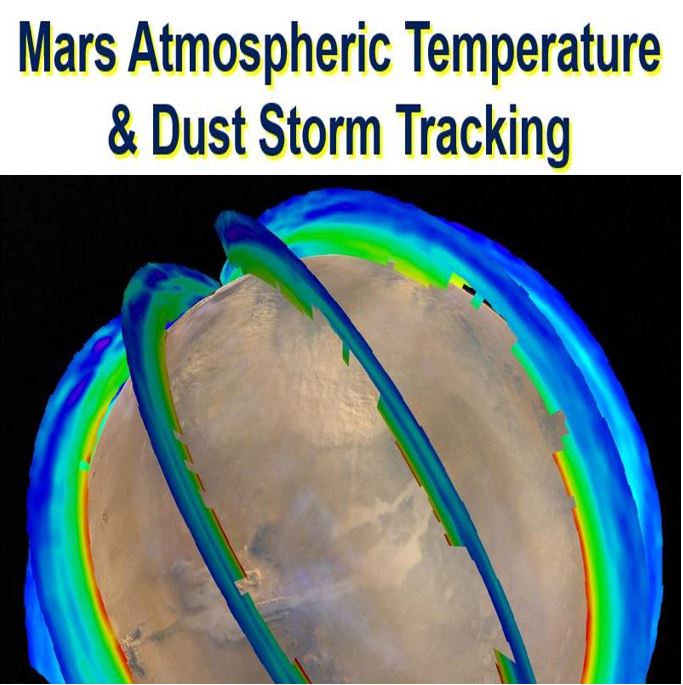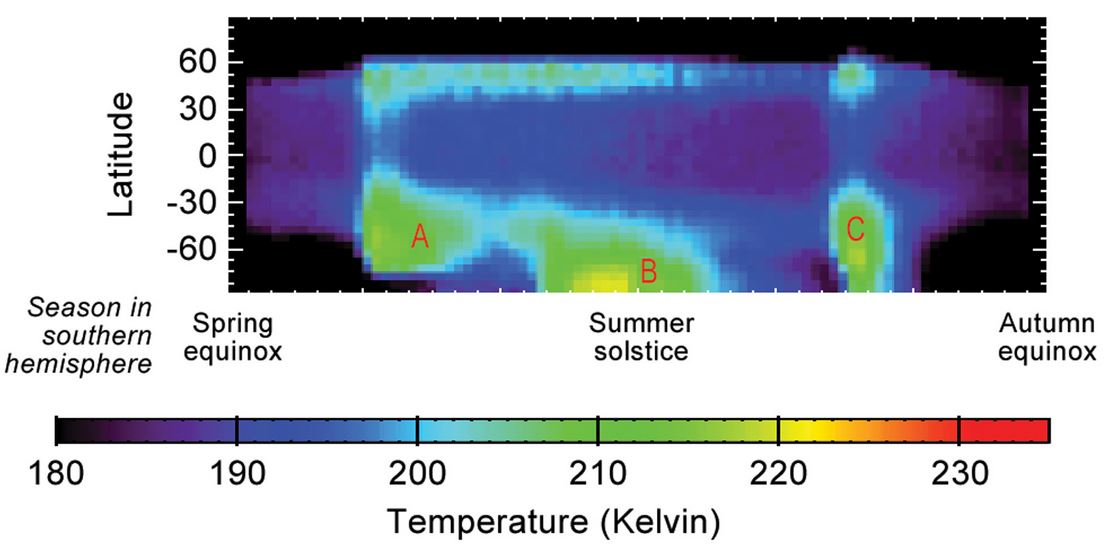A dust storm pattern has been detected by NASA Mars orbiters – scientists said that a pattern of three big regional storms occurs with similar timing virtually every Mars year. NASA orbiters, which have been monitoring the Red Planet since 1997, detected the seasonal patterns from dust storms’ effects on atmospheric temperatures.
Scientist from NASA’s Jet Propulsion Laboratory, Pasadena, California, said the clearest seasonal patterns come by measuring the temperature of Mars’ atmosphere.
Over a period of six recent Martian years, atmospheric temperature records reveal a pattern of three different types of large regional dust storms taking place in sequence at approximately the same times each year during the southern hemisphere’s spring and summer.
 The graphic above presents Martian atmospheric temperature data as curtains over an image of the Red Planet taken during a regional dust storm. The temperature profiles extend from the surface to about 50 miles up. Temperatures are colour coded, from minus 243°F (purple) to minus 9°F (red). (Image: jpl.nasa.gov)
The graphic above presents Martian atmospheric temperature data as curtains over an image of the Red Planet taken during a regional dust storm. The temperature profiles extend from the surface to about 50 miles up. Temperatures are colour coded, from minus 243°F (purple) to minus 9°F (red). (Image: jpl.nasa.gov)
One year in Mars is quite long – equal to about two Earth years.
Observing temperature structure rather than dust
David Kass, who works at NASA’s Jet Propulsion Laboratory, Pasadena, California, said:
“When we look at the temperature structure instead of the visible dust, we finally see some regularity in the large dust storms.”
Dr. Kass, the Instrument Scientist for the Mars Climate Sounder on NASA’s Mars Reconnaissance Orbiter, and colleagues, wrote about their findings in the scientific journal Geophysical Research Letters (citation below).
Dr. Kass said:
“Recognizing a pattern in the occurrence of regional dust storms is a step toward understanding the fundamental atmospheric properties controlling them. We still have much to learn, but this gives us a valuable opening.”
Dust lofted by winds on Mars links directly to atmospheric temperature, the authors explained. The dust absorbs sunlight – the Sun heats dusty air considerably more than clear air.
 Martian atmospheric temperature data related to seasonal patterns in occurrence of large regional dust storms. The data shown here were gathered by the Mars Climate Sounder instrument on NASA’s Mars Reconnaissance Orbiter over the course of 1.5 Martian years, during 2012 and 2013. (Image: jpl.nasa.gov. Credit: NASA/JPL-Caltech)
Martian atmospheric temperature data related to seasonal patterns in occurrence of large regional dust storms. The data shown here were gathered by the Mars Climate Sounder instrument on NASA’s Mars Reconnaissance Orbiter over the course of 1.5 Martian years, during 2012 and 2013. (Image: jpl.nasa.gov. Credit: NASA/JPL-Caltech)
Dusty air warmer than clear air
In some cases, the increase in temperature can be significant, with a difference of more than 35°C (63°F) between clean air and dusty air.
Global wind distribution is also affected by this heating, which can produce downward motion that heats up the air outside the dust-heated areas. Thus, temperature observations capture not only the direct effects of dust storms on the atmosphere, but also the indirect effects.
Being better able to predict large-scale and potentially hazardous dust storms on the Red Planet will also have safety benefits for planning human and robotic missions to the planet’s surface.
By recognizing patterns and types of dust storms, scientists can also make progress towards understanding how seasonal local events affect the weather across the planet in a typical Mars year.
The Mars Climate Sounder on Mars Reconnaissance Orbiter, which reached the Red Planet in 2006, and the Thermal Emission Spectrometer on Mars Global Surveyor, which studied Mars from 1997 to 2006, have assessed atmospheric temperature using infrared observations.
The researchers analysed and gathered temperature data representative of a broad layer centred about twenty-five kilometres (16 miles) above the Martian surface. At that altitude, the atmosphere is more affected by regional storms than local ones.
Most dust storms small – some larger
The majority of Martian dust storms are smaller than 2,000 kilometres (about 1,200 miles) across and dissipate rapidly – within a few days.
Some dust storms become regional, affecting up to one third of the whole planet, and can last up to three weeks. A few may even encircle the planet, covering the southern hemisphere. In 1997, on two occasions global dust storms enveloped the whole planet completely.
How large regional dust storms in Martian years – that include global dust storms – behave is still unclear. Years with a global storm were not included in this latest study.
In each of the six Martian years that were investigated in this study, three large regional storms – dubbed types A, B and C – all appeared.
In the Martian northern autumn, multiple small storms form sequentially near the north pole, similar to our cold-season arctic storms that swing in succession across North America.
Most storms move southward from north
Dr. Kass said:
“On Mars, some of these break off and head farther south along favored tracks. If they cross into the southern hemisphere, where it is mid-spring, they get warmer and can explode into the much larger Type A dust storms.”
Mars’ orbit is quite different from Earth, hence its southern hemisphere spring and summer are much warmer than the northern spring and summer – it is closest to the Sun near the end of southern spring.
Scientists have long-known that southern spring and summer are the dustiest parts of the Martian year, as well as the season of global dust storms, even though the more detailed pattern documented in this new report had never been described before.
Dust attracts more heat and stronger storms
When a Type A dust storm from the north moves into the southern-hemisphere spring, the atmosphere warms as sunlight hits the dust particles. The surge in energy boosts the wind-speed. The more powerful wind lifts more dust, which further expands the area and vertical reach of the storm.
The Type B storm, on the other hand, starts near to the South Pole not long before the beginning of the southern summer. Scientists believe it probably originates from winds generated at the edge of the retreating south-polar carbon dioxide ice cap.
After the Type B storm ends, the Type C starts. Type C originates in the north during the northern winter – or southern summer – and moves to the southern hemisphere in the same way a Type A storm does.
Type C storms vary more in strength from one year to another in terms of duration and peak temperature than the other two storm types do.
Citation: “Interannual similarity in the Martian atmosphere during the dust storm season,” D.M. Kass, A. Kleinbohl, D.J. McCleese, J.T. Schofield and M.D. Smith. Geophysical Research Letters. 7 June 2016. DOI:10.1002/2016GL068978.
Video – Journey of a lifetime – Mars
Today, NASA wants you to participate in the monumental journey of a lifetime – the journey to Mars.
